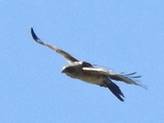We seek your help with research on Little Eagles by reporting your sightings from the ACT region. Information about the research is provided below, where there is also a link to
recent media coverage about an ACT Little Eagle which is currently visiting Daly Waters (Northern Territory).
All we ask is simply to email your Little Eagle sightings to the chatline and ideally to us as well. Thanks in anticipation! We will also be watching ebird and Canberra Nature
Map for sightings reported there.
In August-November we will be asking for observations of
pairs of Little Eagles to help us look for additional local nests. We will email about that closer to the time.
Thanks!
Don Fletcher and Michael Mulvaney.
and m("ACT.gov.au","Michael.Mulvaney");">
0428 48 9990 and 6205 9964
___________________________________________________________________________________________________________________________
WHY ARE WE MAKING THIS REQUEST FOR LITTLE EAGLE OBSERVATIONS?
We seek the help of COG members and others to support research on Little Eagles by reporting sightings from the ACT region. Some explanation about the research follows.
Recent News
Many of you will be aware from previous posts and media coverage of the male Little Eagle from Riverview whose tracker shows he has been near Daly Waters (NT) for several weeks. The media release
here includes photos and a map, and a request for observations.
This is his second winter foray away from our region since the tracker was attached. Based on the previous year, we hope to see him back at Riverview in September in time for the 2017 breeding season.
What information is required about this species?
Little Eagles are one of the most poorly known birds of prey, so there is much to learn. The Action Plan for the Little Eagle makes it a priority to obtain information about habitat use and movement patterns. A knowledge of year round population
movements will assist conservation of the eagles in the ACT and beyond. Such information will also improve the understanding of habitat use, breeding, feeding and threats. Movements are expected to vary with age, sex and seasonal conditions. Tracking and banding
will eventually yield information on age of first breeding, longevity, nest fidelity and mate fidelity.
Multi-agency collaborative research
The study initiated in 2015 to look at the movements of the Riverview pair has been a helpful start. The behaviour of the Riverview male is fascinating but information from multiple birds is essential. It is time now to broaden the research
to look at the local population of Little Eagles. With this in mind, a new coalition of researchers and developers has formed, including Government, CSIRO, Universities and Ginninderry Joint Venture. The group will be ready to attach tracking packs to more
Eagles in time for the coming breeding season.
Female of 1st Inner North pair; Female of 2nd Belconnen pair; Male of 2nd Belconnen pair.
Tracking backback design
|
The tracker is a 22g solar powered backpack which the manufacturer expects to work for 18 – 36 months. The $4,200 tracker records its GPS position at scheduled times each day and transfers these
coordinates to the researcher the next day via satellites and the internet. The harness is designed to break after several years, releasing the eagle from the backpack. The backpack also transmits a radio pulse for a brief time each day and this enables it
to be located manually.
|
|

Tracking pack visible on male of 1st Belconnen pair
|
Leg Bands
Because this is a long-lived species, it seems likely that tracked individuals will remain in, or continue returning to, the ACT region for years after their tracking packs have dropped off. For that reason, coloured leg bands with large
numbers will also be fitted which will enable researchers and COG members to identify individuals flying overhead using powerful cameras. Telescopic observation of perched birds is potentially another way to read the bands although the feathered ‘boots’ may
obscure the band during perching. Long-term observations of identifiable birds could contribute to solving questions about mate fidelity, nest fidelity, longevity and age of first breeding. We will give information about banding in a future email.
Nest cameras
Recording prey brought to the nest with automatic cameras will be an adjunct to conventional diet analysis of regurgitated pellets and prey remains.
Local breeding territories
For the research to proceed it is essential to have a pool of nesting pairs to work with. Four were found in 2016 but we became increasingly aware how well a breeding pair can remain undetected. As well as checking the territories that
were active in 2016, in 2017 we will make targeted searches in other places where Little Eagles have been sighted.
Two Belconnen pairs and two Inner-North pairs commenced nesting In 2016. (The exact locations are not revealed on line.) One pair abandoned but at least two others fledged one young. It seems that there are more breeding pairs and active
nests to be found by careful observation during the 2017 season. Areas of particular interest will be (a) south of the Molonglo, (b) the area to the west of a line from Narrabundah Hill to Mt Stromlo, and (c) nearby NSW, additional to the nest on Sutton Rd,
which also produced a fledgling in 2016.
WHAT WE ARE ASKING FROM COG MEMBERS
We will email separately about August-November observations closer to the time.
Right now (May- July) there are a few Little Eagles remaining in Canberra such as the one reported on this chatline which was regularly roosting on Red Hill during April. No one knows what proportion of these are (a) adults remaining on
their summer territories; (b) adults relocated, (c) juveniles, or (d) (d) adults from elsewhere possibly in transit through the ACT. We are keen to find out more about these ‘winter eagles’ and would appreciate being told of any sightings of Little Eagles
so we can identify locations where a bird is being seen repeatedly. Simply report your sightings to ourselves as well as to the chatline.
Regards, Michael Mulvaney and Don Fletcher

